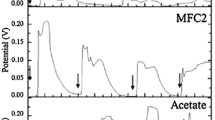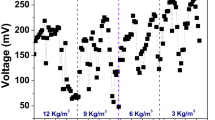Abstract
In the present study, the valorization of cheese whey (CW) as an electron donor in an air-cathode single-chamber microbial fuel cell (MFC) was studied. Filter-sterilized raw and pretreated-acidified diluted CW (after 48 h of fermentation at mesophilic temperature) were used as substrates, in order to investigate the effect of the two different handlings on the MFC performance. The pretreatment-acidification experiments were performed under different operational conditions (initial dilutions giving chemical oxygen demand (COD) concentrations of 2 and 4 g/L as well as initial pH adjusted to 6.7 and without pH adjustment) in order to obtain maximum acidification efficiency and energy recovery, in the form of hydrogen. The effect of organic load on the efficiency of the MFC was studied, aiming at exploring the possibility of achieving a successful operation at the highest possible initial concentration of CW (smallest dilution). The experimental results showed that CW is a suitable and promising substrate for electricity production using MFC, with a maximum power density of 3.26 W/m3 (0.33 MJ/kg COD) for filter-sterilized CW diluted to an initial concentration of 0.8 g COD/L. Combining MFC technology with the pretreatment/acidification process, during which hydrogen is also produced, a total energy of 2.37 MJ/kg COD could be recovered.

Graphical abstract





Similar content being viewed by others
References
Valta K, Damala P, Angeli E, Antonopoulou G, Malamis D, Haralambous KJ (2017) Current treatment technologies of cheese whey and wastewater by Greek cheese manufacturing units and potential valorisation opportunities. Waste Biomass Valor 8(5):1649–1663. https://doi.org/10.1007/s12649-017-9862-8
Prazeres AR, Carvalho F, Rivas J (2012) Cheese whey management: a review. J Environ Manag 110:48–68. https://doi.org/10.1016/j.jenvman.2012.05.018
Kasmi M (2018) Biological processes as promoting way for both treatment and valorization of dairy industry effluents. Waste Biomass Valor 9:195–209. https://doi.org/10.1007/s12649-016-9795-7
Antonopoulou G, Stamatelatou K, Venetsaneas N, Kornaros M, Lyberatos G (2008) Biohydrogen and methane production from cheese whey in a two–stage anaerobic process. Ind Eng Chem Res 47(15):5227–5233. https://doi.org/10.1021/ie071622x
Venetsaneas N, Antonopoulou G, Stamatelatou K, Kornaros M, Lyberatos G (2009) Using cheese whey for hydrogen and methane generation in a two-stage continuous process with alternative pH controlling approaches. Bioresour Technol 100:3713–3717. https://doi.org/10.1016/j.biortech.2009.01.025
Stamatelatou K, Antonopoulou G, Tremouli A, Lyberatos G (2011) Production of gaseous biofuels and electricity from cheese whey. Ind Eng Chem Res 50:639–644. https://doi.org/10.1021/ie1002262
Stamatelatou K, Giantsiou N, Diamantis V, Alexandridis C, Alexandridis A, Aivasidis A (2014) Biogas production from cheese whey wastewater: laboratory- and full-scale studies. Water Sci Technol 69(6):1320–1325. https://doi.org/10.2166/wst.2014.029
Antonopoulou G, Stamatelatou K, Bebelis S, Lyberatos G (2010) Electricity generation from synthetic substrates and cheese whey using a two chamber microbial fuel cell. Biochem Eng J 50:10–15. https://doi.org/10.1016/j.bej.2010.02.008
Chen S, Patil SA, Brown RK, Schröder U (2019) Strategies for optimizing the power output of microbial fuel cells: transitioning from fundamental studies to practical implementation. Appl Energy 233-234:15–28. https://doi.org/10.1016/j.apenergy.2018.10.015
Christwardana M, Frattini D, Duarte KDZ, Accardo G, Kwon K (2019) Carbon felt molecular modification and biofilm augmentation via quorum sensing approach in yeast-based microbial fuel cells. Appl Energy 238:239–248. https://doi.org/10.1016/j.apenergy.2019.01.078
Li C, Cheng S (2019) Functional group surface modifications for enhancing the formation and performance of exoelectrogenic biofilms on the anode of a bioelectrochemical system. Crit Rev Biotechnol 39(8):1015–1030. https://doi.org/10.1080/07388551.2019.1662367
Tremouli A, Martinos M, Bebelis S, Lyberatos G (2016) Performance assessment of a four-air cathode single-chamber microbial fuel cell under conditions of synthetic and municipal wastewater treatments. J Appl Electrochem 46:515–525. https://doi.org/10.1007/s10800-016-0935-3
Antonopoulou G, Ntaikou I, Pastore C, di Bitonto L, Bebelis S, Lyberatos G (2019) An overall perspective for the energetic valorization of household food waste using microbial fuel cell technology of its extract, coupled with anaerobic digestion of the solid residue. Appl Energy 238:239–248. https://doi.org/10.1016/j.apenergy.2019.03.082
Ghasemi M, Ahmad A, Jafary T, Azad AK, Kakooei S, Wan Daud WR, Sedighi M (2017) Assessment of immobilized cell reactor and microbial fuel cell for simultaneous cheese whey treatment and lactic acid/electricity production. Int J Hydrog Energy 42(14):9107–9115. https://doi.org/10.1016/j.ijhydene.2016.04.136
Moreno R, Escapa A, Cara J, Carracedo B, Gomez X (2015) A two-stage process for hydrogen production from cheese whey: integration of dark fermentation and biocatalyzed electrolysis. Int J Hydrog Energy 40(1):168–175. https://doi.org/10.1016/j.ijhydene.2014.10.120
Kelly PT, He Z (2014) Understanding the application niche of microbial fuel cells in a cheese wastewater treatment process. Bioresour Technol 157:154–160. https://doi.org/10.1016/j.biortech.2014.01.085
Callegari A, Cecconet D, Molognoni D, Capodaglio AG (2018) Sustainable processing of dairy wastewater: long-term pilot application of a bio-electrochemical system. J Clean Prod 189:563–569. https://doi.org/10.1016/j.jclepro.2018.04.129
Cecconet D, Molognoni D, Callegari A, Capodaglio AG (2018) Agro-food industry wastewater treatment with microbial fuel cells: energetic recovery issues. Int J Hydrog Energy 43:500–511. https://doi.org/10.1016/j.ijhydene.2017.07.231
Fradler KR, Kim JR, Shipley G, Massanet-Nicolau J, Dinsdale RM, Guwy AJ, Premier GC (2014) Operation of a bioelectrochemical system as a polishing stage for the effluent from a two-stage biohydrogen and biomethane production process. Biochem Eng J 85:125–131. https://doi.org/10.1016/j.bej.2014.02.008
Hydrogen production in a microbial electrolysis cell fed with a dark fermentation effluent. J Appl Electrochem 45:1223–1229. https://doi.org/10.1007/s10800-015-0864-6
Zhuang L, Zhou S, Wang Y, Liu C, Geng S (2009) Membrane-less cloth cathode assembly (CCA) for scalable microbial fuel cells. Biosens Bioelectron 24:3652–3656. https://doi.org/10.1016/j.procbio.2010.02.014
APHA, AWWA, WPCF (1995) In: Franson MA (ed) Standard methods for the examination of water and wastewater. American Public Health Association, Washington, DC
DuBois M, Gilles K, Hamilton J, Rebers P, Smith F (1956) Colorimetric method for determination of sugars and related substances. Anal Chem 28:350–356. https://doi.org/10.1021/ac60111a017
Miller GL (1959) Use of dinitrosalicylic acid reagent for determination of reducing sugars. Anal Chem 31:426–428. https://doi.org/10.1021/ac60147a030
Antonopoulou G, Gavala HN, Skiadas IV, Angelopoulos K, Lyberatos G (2008) Biofuels generation from sweet sorghum: fermentative hydrogen production and anaerobic digestion of the remaining biomass. Bioresour Technol 9(1):110–119. https://doi.org/10.1016/j.biortech.2006.11.048
Antonopoulou G, Gavala HN, Skiadas IV, Lyberatos G (2010) Influence of pH in fermentative hydrogen production from sweet sorghum extract. Int J Hydrogen Energy 35:1921–1928. https://doi.org/10.1016/j.ijhydene.2009.12.175
Kumar R, Singh L, Zularisam AW, Hai FI (2018) Microbial fuel cell is emerging as a versatile technology: a review on its possible applications, challenges and strategies to improve the performances. Int J Energy Res 42:369–394. https://doi.org/10.1002/er.3780
Tremouli A, Antonopoulou G, Bebelis S, Lyberatos G (2013) Operation and characterization of a microbial fuel cell fed with pretreated cheese whey at different organic loads. Bioresour Technol 131:380–389. https://doi.org/10.1016/j.biortech.2012.12.173
You S, Zhao Q, Zhang J, Jiang J, Wan C, Du M, Zhao S (2007) A graphite-granule membrane-less tubular air-cathode microbial fuel cell for power generation under continuously operational conditions. J Power Sources 173:172–177. https://doi.org/10.1016/j.jpowsour.2007.07.063
Zhuang L, Feng C, Zhou S, Li Y, Wang Y (2010) Comparison of membrane- and cloth-cathode assembly for scalable microbial fuel cells: construction, performance and cost. Process Biochem 45:929–934. https://doi.org/10.1016/j.procbio.2010.02.014
Kim H, Kim B, Yu J (2015) Power generation response to readily biodegradable COD in single-chamber microbial fuel cells. Bioresour Technol 186:136–140. https://doi.org/10.1016/j.biortech.2015.03.066
Fan Y, Hu HU, Liu H (2007) Sustainable power generation in microbial fuel cells using bicarbonate buffer and proton transfer mechanisms. Environ Sci Technol 41:8154–8158. https://doi.org/10.1021/es071739c
Rabaey K, Boon N, Siciliano SD, Verhaege M, Verstraete W (2004) Biofuel cells select for microbial consortia that self-mediate electron transfer. Appl Environ Microbiol 70:5373–5382. https://doi.org/10.1128/AEM.70.9.5373-5382.2004
Matz C (2011) Competition, communication, cooperation: molecular crosstalk in multi-species biofilms. In: Springer Berlin Heidelberg, pp 29–40. https://doi.org/10.1007/978-3-642-19940-0_2
Cecconet D, Bolognesi S, Molognonia D, Callegari A, Capodaglio AG (2018) Influence of reactor’s hydrodynamics on the performance of microbial fuel cells. J Water Process Eng 26:281–288. https://doi.org/10.1016/j.jwpe.2018.10.019
Logan BE, Hamelers B, Rozendal R, Schroeder U, Keller J, Freguia S, Aelterman P, Verstraete W, Rabaey K (2006) Microbial fuel cells: methodology and technology. Env Sci Technol 40:5181–5192. https://doi.org/10.1021/es0605016
Funding
This research about MFCs has been co-funded by the European Union (_European_Regional_Development Fund_-ERDF) and Greek national funds through the Operational Program “Competitiveness, Entrepreneurship and Innovation 2014-2020” of the National Strategic Reference Framework (NSRF)-Research Funding Program: WE-MET research project “Sustainable wastewater treatment combined with energy recovery with microbial electrochemical technologies”. The research regarding pretreatment-acidification has been funded in the frame of research project: «APPLICATION OF MICROBIAL ELECTROCHEMICAL TECHNOLOGIES TOWARDS ADVANCED BIOFUELS PRODUCTION», which is supported by the 1st Call for H.F.R.I. Research Projects for the support of Post-doctoral Researchers.
Author information
Authors and Affiliations
Corresponding author
Additional information
Publisher’s Note
Springer Nature remains neutral with regard to jurisdictional claims in published maps and institutional affiliations.
Rights and permissions
About this article
Cite this article
Antonopoulou, G., Ntaikou, I., Bebelis, S. et al. On the evaluation of filtered and pretreated cheese whey as an electron donor in a single chamber microbial fuel cell. Biomass Conv. Bioref. 11, 633–643 (2021). https://doi.org/10.1007/s13399-020-00653-w
Received:
Revised:
Accepted:
Published:
Issue Date:
DOI: https://doi.org/10.1007/s13399-020-00653-w




